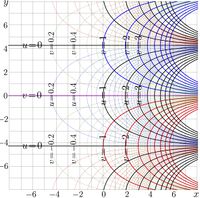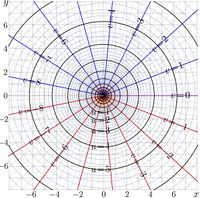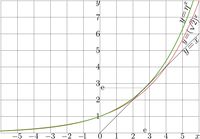Base e1e


Base e1e refers to the value of base $b= \eta =\exp(1/\mathrm e)\approx 1.4446678610$
and corresponding exponential, SuperExponential (in particular, the tetration) and the inverse functions. In future, this may refer also to the highest Ackermann functions to this base.
The specific value of $b$ corresponds to the single real fixed point of the exponential. For this case, the special formalism of exotic iteration had been developed. [1]
The special name, for example, Henryk constant, is required for the base $~b=\exp(1/\mathrm e)\approx 1.4446678610~$ , and notation $\eta$ is suggested for this value of $b$.
Contents
Exponent and logarithm to base e1e
The complex maps of $f=\exp_\eta$ and $f=\log_\eta$ are shown in figures at right with lines $u+\mathrm i v = f(x+\mathrm i y)$ in the $x$,$y$ plane. These pictures look similar to those for the case $b=\sqrt{2}\approx 1.414$, see article Base sqrt2. and those for the case $b=3/2=1.5$, see article Base 1.5.
Fixed points
Values of the fixed points and behaviour of the superfunctions and the Abel functions are pretty different for the similar values of base $b$ mentioned above.
At base $b=\sqrt{2}\approx 1.414$, there exist two real fixed points, $L_1=2$ and $L_2=4$.
At base $b=\eta=\exp(1/\mathrm e)\approx 1.444$, there exist two real fixed points, $L=\mathrm e \approx 2.71$.
At base $b=1.5$, there exist no real fixed points, and the superexponential is supposed to approach the complex fixed points $L$ and $L^*$ at the infinity; correspondently, the AbelExponential, the ArcTetration $\mathrm{ate}$ has branch points at these values.
The explicit plot of exponential to base $\eta$
Superexponentials to base $\eta$
For the base $b=\eta=\exp(1/\mathrm e)$, the asymptotic expansion of the superexponential can be written in the following form:
$\displaystyle \tilde F(z)=\mathrm e\cdot\left(1-\frac{2}{z}\left( 1+\sum_{m=1}^{M} \frac{P_{m}\big(-\ln(\pm z) \big)}{(3z)^m} +\mathcal{O}\!\left(\frac{|\ln(z)|^{m+1}}{z^{m+1}}\right) \right) \right) $
where $P$ are polynomials;
$ P_{1}(t)=t $
$P_{2}(t)=t^{2}+t+1/2 $
$P_{3}(t)=t^{3}+\frac{ 5}{ 2}t^{2}+\frac{ 5}{2}t +\frac{ 7}{10} $
$P_{4}(t)=t^{4}+\frac{13}{ 3}t^{3}+\frac{ 45}{6}t^{2}+\frac{53}{10}t +\frac{ 67}{60} $
$P_{5}(t)=t^{5}+\frac{77}{12}t^{4}+\frac{101}{6}t^{3}+\frac{83}{ 4}t^{2}+\frac{653}{60}t+\frac{2701}{1680}$
...
More polynomials $P$ can be calculated substituting representation $\tilde F$ into the transfer equation
$ \tilde F(z\!+\!1)=\exp_\eta(\tilde F(z))$
and performing the asymptotic analysis at large $|z|$.
References
- ↑
http://www.ams.org/journals/mcom/0000-000-00/S0025-5718-2012-02590-7/S0025-5718-2012-02590-7.pdf
http://mizugadro.mydns.jp/PAPERS/2012e1eMcom2590.pdf H.Trappmann, D.Kouznetsov. Computation of the Two Regular Super-Exponentials to base exp(1/e). Mathematics of Computation. Math. Comp., v.81 (2012), p. 2207-2227. ISSN 1088-6842(e) ISSN 0025-5718(p)
